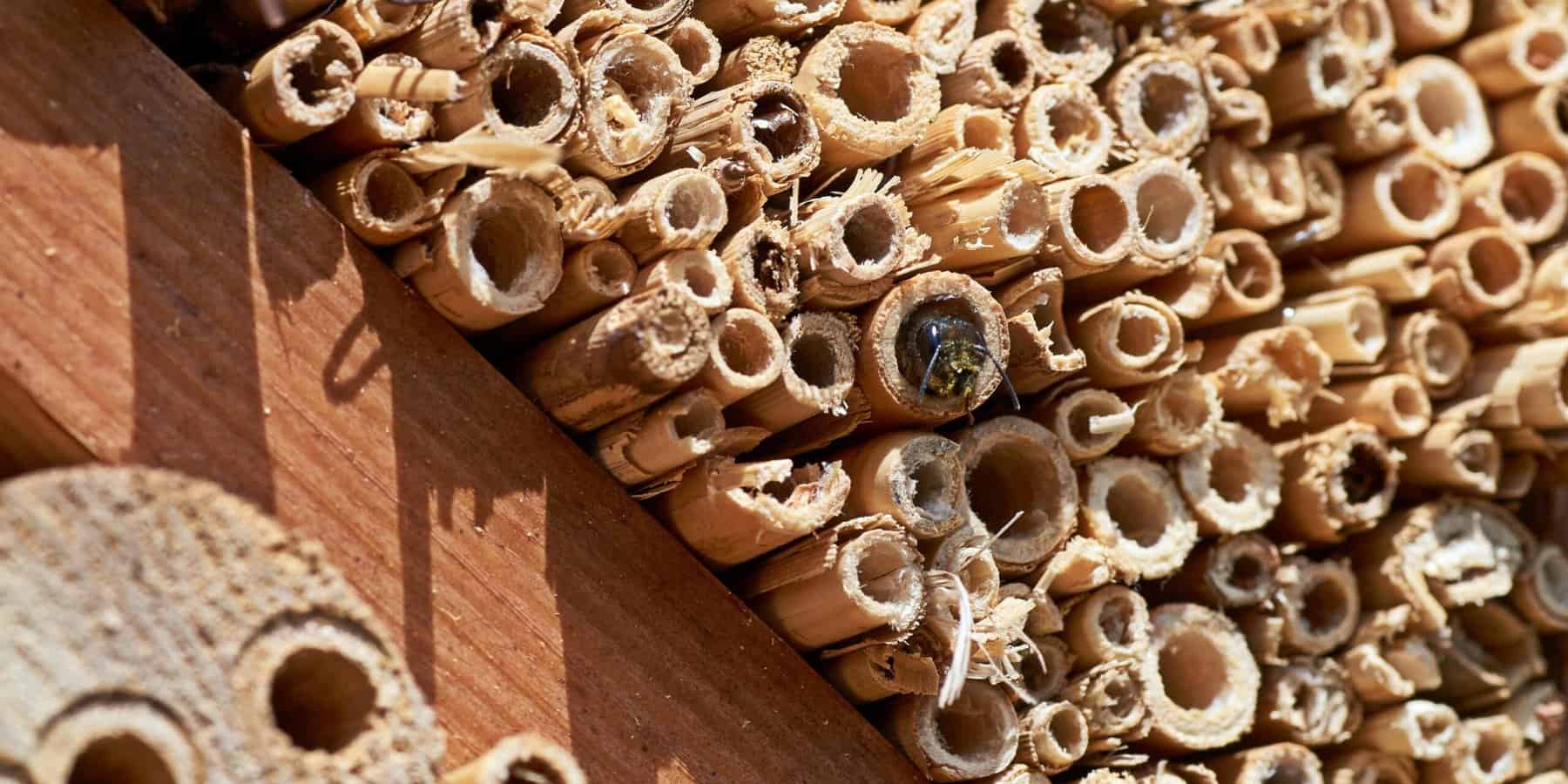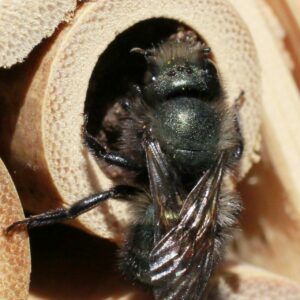Shop Mother’s Day Bouquets
Figaro's Blog

From mason bees to leafcutters, British Columbia’s native bees are fascinating creatures! These gentle pollinators are excellent foragers, making them beneficial to both backyard gardens and commercial agriculture. As interest in sustainable practices grows, many BC residents are turning to native beekeeping as a rewarding hobby that supports local ecosystems. In this guide, we’ll learn more about mason bees: the most accessible of our native bees. Learn how you can get started with mason beekeeping and enhance garden productivity with mason bees.
Why Mason Bees?

Mason bees excel at pollination: six mason bees can pollinate a fruit tree, whereas it would take 600 honey bees to pollinate the same tree!
Mason bees, also known as orchard bees or blue orchard bees, are native to North America and are renowned for their ability to pollinate. They are solitary bees, meaning they do not live in hives or colonies like honeybees. Instead, female mason bees build individual nests in narrow cavities such as hollow stems, reeds, or tunnels in wood.
A single mason bee can pollinate as many flowers as 100 honeybees, making them incredibly valuable for fruit and vegetable production. They are also non-aggressive and safe to keep around children and pets, making them an excellent choice for backyard beekeeping.
Getting Started with Mason Beekeeping
Before diving into mason beekeeping, take some time to learn about these interesting insects. Understanding their biology and behaviour is crucial for successful mason beekeeping. Here’s what you need to know:
The mason bee life cycle
Mason bees have a fascinating life cycle. They emerge from their cocoons in early spring as adults, mate, and then females begin searching for nesting sites. After finding a suitable location, typically a narrow cavity such as a hollow stem or a pre-made nesting block, the female bee begins constructing individual nest chambers using mud. She provisions each chamber with a mixture of pollen and nectar, lays an egg, seals the chamber, and repeats the process until the cavity is full. After approximately six weeks, the adult bee dies. The eggs hatch into larvae, which feed on the pollen and nectar before pupating and eventually emerging as adult bees the following spring.
Mason bee behaviour
Unlike honeybees, which live in colonies, mason bees are solitary insects: they work independently, have no queen, and do not produce honey. They are very fast, not aggressive, and will not swarm. However, they are excellent pollinators, with each female bee capable of visiting hundreds of flowers per day. Their gentleness makes them safe to keep in residential areas.
Mason bee habitat requirements
Mason bees require suitable nesting sites and access to food sources. Providing nesting sites with the right dimensions and materials aids their survival. Additionally, having a variety of flowering plants within 300 feet of their nesting site ensures that they have an adequate supply of pollen and nectar.
Setting up mason bee nesting sites
Creating suitable nesting sites is important for attracting and supporting mason bee populations in your garden. Here’s how to do it effectively:
Provide nesting materials
You can purchase or make nesting blocks or tubes specifically designed for mason bees. These can be filled with paper liners or reeds, providing individual chambers for the bees to lay their eggs. Ensure that the nesting materials are of the appropriate size and texture for mason bees to construct their nests: 16-18mm nesting holes are preferred by mason bees.
Placing mason bee houses
Choose a sunny location (ideally, one that gets morning sun; southeast is preferred) in your garden to place the nesting sites. Mason bees prefer warm, sheltered spots that are protected from strong winds and rain. Mount the nesting blocks or tubes on a sturdy structure, such as a fence or wall, at eye level or slightly higher. Figaro’s Garden is carrying houses from Bee Canadian.
Setting out mason bee cocoons
Mason bee cocoons can be overwintered or purchased new. Set them out, ideally adjacent to your chosen nesting site, once temperatures are reliably above 10°C. In Vancouver, the first two weeks of April are typically ideal.
Maintaining mason bee houses
Check the nesting sites regularly for signs of activity, such as bees entering and exiting the tubes or sealed mud chambers indicating completed nests. Clean and replace nesting materials annually to prevent the buildup of pests or pathogens.
Providing sources of food for mason bees
To attract and sustain mason bees in your garden, it’s essential to provide them with a diverse array of flowering plants. Here’s how to create a bee-friendly garden:
Plant selection
Choose a variety of flowering plants that bloom at different times throughout spring. Include early-blooming native species as they are well-adapted to our local climate and provide valuable resources for native pollinators like mason bees. Don’t limit yourself to natives, however: Pieris, Daphne, and Heather are mason bee favourites!
Habitat enhancement
If you have the space, create habitat features like hedgerows, meadows, or wildflower patches to provide additional foraging opportunities for mason bees and other pollinators. Avoid the use of pesticides and herbicides in your garden, as these chemicals can harm bees and other beneficial insects.
Monitor and maintain nests
Regular monitoring and maintenance of nesting sites are essential for ensuring the health and productivity of mason bee populations. Here’s what to look out for:
- Observe the nesting sites throughout the spring and early summer months for signs of mason bee activity. Look for bees entering and exiting the tubes or nesting blocks, carrying pollen or mud.
- Periodically inspect the nesting materials for signs of damage, disease, or pests. Remove any debris or buildup of mud and replace damaged or soiled nesting materials as needed.
- Keep an eye out for birds or rodents trying to eat mason bee larvae or pupae: install a predator guard if needed.
Harvesting and storing mason bee cocoons
In the fall, after the mason bees have completed their life cycle, you can harvest the cocoons from the nesting materials to ensure their survival over the winter. Here’s how to do it:
1. Carefully remove the nesting materials from the nesting blocks or tubes and gently extract the cocoons. Handle the cocoons with care to avoid damaging them.
2. Rinse the cocoons in lukewarm water to remove any remaining mud or debris. Allow them to air dry thoroughly before storage.
3. Place the clean, dry cocoons in a breathable container, such as a mesh bag or paper bag, and store them in the crisper drawer of your refrigerator. Avoid exposing the cocoons to extreme temperatures or high humidity, as this can affect their viability.
4. Keep the cocoons stored over the winter months until the following spring, when you can release them back into your garden to continue their life cycle. Ensure that the release location has suitable nesting sites and food sources to support the emerging bees.
Figaro’s Garden loves mason bees!
Mason beekeeping offers a rewarding and sustainable way to support local ecosystems while enjoying the benefits of improved pollination in your garden. By providing suitable nesting sites and food sources, you can create a welcoming environment for these gentle pollinators. Whether you’re a seasoned beekeeper or just starting, mason beekeeping is a rewarding hobby that anyone can enjoy.
Figaro’s Garden carries mason bee cocoons, reeds, and houses in the early spring months. Contact us today to reserve yours!
plants make everything better
Whether you're an experienced horticulturist, or looking for your first plant, our team at Figaro's Garden is excited to help you realize your plant and garden dreams. Contact us today or stop by the shop to see what's in-store.




